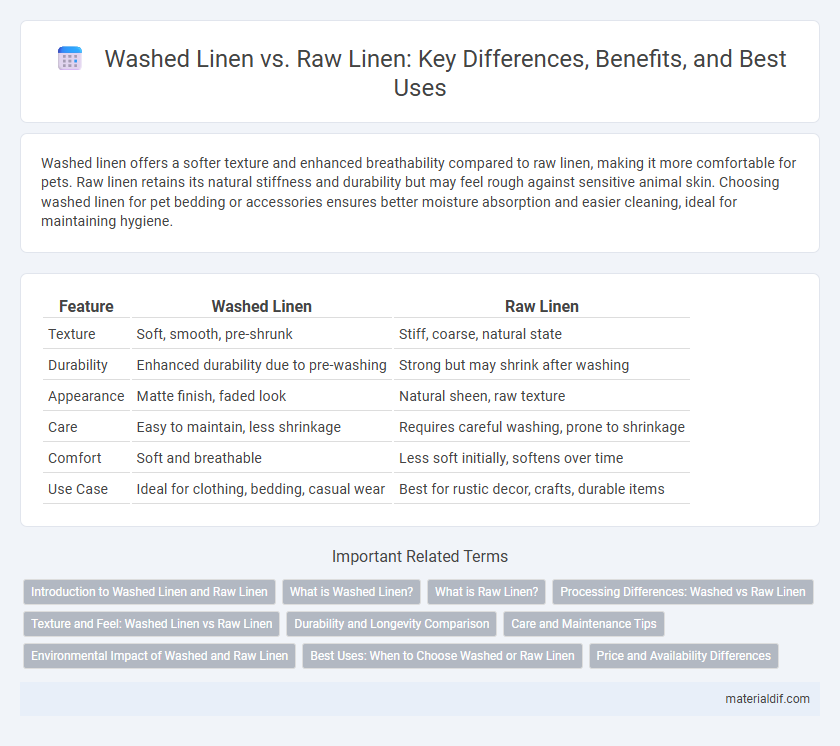Washed linen offers a softer texture and enhanced breathability compared to raw linen, making it more comfortable for pets. Raw linen retains its natural stiffness and durability but may feel rough against sensitive animal skin. Choosing washed linen for pet bedding or accessories ensures better moisture absorption and easier cleaning, ideal for maintaining hygiene.
Table of Comparison
| Feature | Washed Linen | Raw Linen |
|---|---|---|
| Texture | Soft, smooth, pre-shrunk | Stiff, coarse, natural state |
| Durability | Enhanced durability due to pre-washing | Strong but may shrink after washing |
| Appearance | Matte finish, faded look | Natural sheen, raw texture |
| Care | Easy to maintain, less shrinkage | Requires careful washing, prone to shrinkage |
| Comfort | Soft and breathable | Less soft initially, softens over time |
| Use Case | Ideal for clothing, bedding, casual wear | Best for rustic decor, crafts, durable items |
Introduction to Washed Linen and Raw Linen
Washed linen undergoes a cleaning and softening process that enhances its texture, making it more durable and comfortable for everyday use. Raw linen, in contrast, is untreated and retains its natural stiffness and rougher feel, preserving its organic fibers and original appearance. Choosing between washed and raw linen depends on the desired softness, durability, and aesthetic preferences for home textiles or garments.
What is Washed Linen?
Washed linen is fabric that has undergone a pre-washing process to soften its texture and reduce shrinkage, making it more comfortable and easier to care for. This treatment enhances the linen's natural breathability and gives it a lived-in, relaxed appearance without compromising durability. Compared to raw linen, washed linen is less stiff, less prone to wrinkles, and ready to use immediately after purchase.
What is Raw Linen?
Raw linen refers to flax fibers that have undergone minimal processing, retaining their natural texture and strength. Unlike washed linen, which is softened and smoothed through washing, raw linen remains coarse and stiffer, offering a more rustic and durable fabric option. Its natural irregularities make it ideal for artisanal and eco-friendly textiles, emphasizing sustainability and authenticity.
Processing Differences: Washed vs Raw Linen
Washed linen undergoes a thorough cleaning and softening process that removes impurities, stabilizes the fabric, and enhances its softness and durability, while raw linen retains its natural stiffness and rough texture due to minimal processing. The washing process involves wetting, beating, and sometimes bleaching, which reduces linen's natural harshness and potential shrinkage. Raw linen, being untreated, offers a sturdier and more rustic feel, suitable for projects requiring a coarse, authentic texture.
Texture and Feel: Washed Linen vs Raw Linen
Washed linen offers a softer, smoother texture due to its pre-washing process, making it more comfortable and less prone to wrinkles compared to raw linen. Raw linen retains a stiff, coarse feel with a more natural, organic texture, which softens over time through use and washing. The tactile experience of washed linen emphasizes comfort and ease, while raw linen highlights durability and a rustic appeal.
Durability and Longevity Comparison
Washed linen undergoes a softening process that enhances its texture while maintaining strong fiber integrity, resulting in durable fabric that often becomes more comfortable and resilient with each wash. Raw linen, untreated and stiffer, may initially exhibit greater tensile strength but lacks the pliability of washed linen, making it prone to stiffness and faster wear under frequent use. Over time, washed linen offers superior longevity due to increased softness and flexibility, reducing fiber breakage and extending the fabric's usable life compared to raw linen.
Care and Maintenance Tips
Washed linen offers enhanced softness and reduced shrinkage compared to raw linen, making it easier to care for with less risk of damage during washing. Raw linen requires gentle handling with cold water and minimal agitation to maintain its natural stiffness and durability. For both types, using mild detergents, air drying, and avoiding high heat prevents fabric weakening and prolongs the lifespan of linen textiles.
Environmental Impact of Washed and Raw Linen
Washed linen undergoes processing that consumes significant water and energy resources, leading to a higher environmental footprint compared to raw linen, which requires minimal treatment. The washing and bleaching stages in linen production release chemicals into water systems, contributing to aquatic pollution, whereas raw linen maintains its natural state with reduced pollution risks. Choosing raw linen supports sustainable practices by minimizing water usage and chemical discharge, aligning with eco-friendly textile goals.
Best Uses: When to Choose Washed or Raw Linen
Washed linen offers a softer texture and enhanced durability, making it ideal for everyday clothing, bedding, and home decor where comfort and ease of care are priorities. Raw linen maintains its natural stiffness and strength, perfect for structured garments, upholstery, and craft projects requiring a crisp, firm fabric. Choosing washed or raw linen depends on the desired finish and use: opt for washed linen for softness and flexibility, raw linen for durability and a more natural appearance.
Price and Availability Differences
Washed linen typically costs more than raw linen due to the additional processing involved, which enhances softness and durability. Raw linen is more readily available and less expensive, appealing to budget-conscious consumers seeking a natural, untreated fabric. Price variations depend on the sourcing and finishing methods, with washed linen often favored in premium home textiles and apparel markets.
Washed Linen vs Raw Linen Infographic

 materialdif.com
materialdif.com